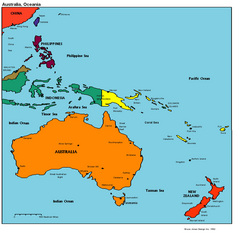The last and final region is Oceania.
The region of Oceania is made up of the following countries: Australia, New Zealand, Papua New Guinea and Pacific Islands.
Population:
The population for Oceania is around 34 million which is smaller than California, yet the land is larger than the US. Islands have younger a much younger population and they are growing rapidly. New Zealand and Australia have an older population and they are growing at a slower rate. The family sizes are smaller and the population is unevenly distributed. Most of the population lives along the east coast and these areas are environmental disasters for the Islands. New Guinea has much higher birth rates due to low education and the fact that they are poor.
Climate:
The climate is mostly warm and humid. In the highlands there is large amounts of rain that can average up to 130 inches year. The low lands don't get as much rain as the high lands they get just a little over 30 inches a year. The south has high winds up to 40 mph and that is on an average of 118 days per year. Around 2/3 of Australia is dry because of the Great Diving Range. Rain is not able to reach the middle of the continent. This area only gets around 20 inches a year. The islands are wet on the windward side and dry on leeward side. Some of them ranging from 60-120 per year. The island that are located on the equator receive less.
Environmental Issues:
untreated sewage, air pollution, noise pollution, loss of forest and plant and wildlife, tourism, global warming, animals
Roles of Gender:
women seen as love objects, they have power and it gets more with motherhood and age, can be a Chief in Polynesia, do crafts and gather food and fish, Micronesia lineage is done through women, careers and school more important, Islands mothers are to mate first then school and careers, Australia men are seen as masculine, white, working laborers, stockbrokers and miners, do the cultivating of foods and cooking,
Resources:
coal, bauxite, wool, timber, unprocessed materials, mining
Agriculture:
60% population are active in agriculture, sheep farming, wine making, dairy products, fruits and fishing
Transportation:
cars, boats
References:
Pulsipher, L.M., Pulsipher, A. (2008). World Regional Geography: Global Patterns, Local Lives (4th ed.). New York: W. H. Freeman and Company.
The population for Oceania is around 34 million which is smaller than California, yet the land is larger than the US. Islands have younger a much younger population and they are growing rapidly. New Zealand and Australia have an older population and they are growing at a slower rate. The family sizes are smaller and the population is unevenly distributed. Most of the population lives along the east coast and these areas are environmental disasters for the Islands. New Guinea has much higher birth rates due to low education and the fact that they are poor.
Climate:
The climate is mostly warm and humid. In the highlands there is large amounts of rain that can average up to 130 inches year. The low lands don't get as much rain as the high lands they get just a little over 30 inches a year. The south has high winds up to 40 mph and that is on an average of 118 days per year. Around 2/3 of Australia is dry because of the Great Diving Range. Rain is not able to reach the middle of the continent. This area only gets around 20 inches a year. The islands are wet on the windward side and dry on leeward side. Some of them ranging from 60-120 per year. The island that are located on the equator receive less.
Environmental Issues:
untreated sewage, air pollution, noise pollution, loss of forest and plant and wildlife, tourism, global warming, animals
Roles of Gender:
women seen as love objects, they have power and it gets more with motherhood and age, can be a Chief in Polynesia, do crafts and gather food and fish, Micronesia lineage is done through women, careers and school more important, Islands mothers are to mate first then school and careers, Australia men are seen as masculine, white, working laborers, stockbrokers and miners, do the cultivating of foods and cooking,
Resources:
coal, bauxite, wool, timber, unprocessed materials, mining
Agriculture:
60% population are active in agriculture, sheep farming, wine making, dairy products, fruits and fishing
Transportation:
cars, boats
References:
Pulsipher, L.M., Pulsipher, A. (2008). World Regional Geography: Global Patterns, Local Lives (4th ed.). New York: W. H. Freeman and Company.

